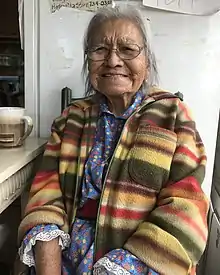Dextra Quotskuyva
Dextra Quotskuyva Nampeyo (born September 7, 1928, Polacca, Arizona) is a Native American potter and artist. She is in the fifth generation of a distinguished ancestral line of Hopi potters.
Dextra Quotskuyva Nampeyo | |
|---|---|
 Photo of Dextra Quotskuyva taken on September 20, 2018, in Kykotsmovi, Arizona. | |
| Born | September 7, 1928 |
| Nationality | American |
| Education | Great-granddaughter of Hopi-Tewa potter Nampeyo |
| Known for | Potter and artist |
| Awards | Proclaimed an “Arizona Living Treasure,” 1994; Arizona State Museum Lifetime Achievement Award, 1998 |
In 1994 Dextra Quotskuyva was proclaimed an “Arizona Living Treasure,” and in 1998 she received the first Arizona State Museum Lifetime Achievement Award.[1] In 2001, the Wheelwright Museum organized a 30-year retrospective exhibition of Quotskuyva's pottery,[2] and in 2004, she received the Southwestern Association for Indian Arts Lifetime Achievement award.[3]
Family
She is the great-granddaughter of Hopi-Tewa potter Nampeyo of Hano, who revived Sikyátki style pottery,[1] descending through her eldest daughter, Annie Healing. Dextra is the daughter of Rachel Namingha (1903–1985), and sister of Priscilla Namingha, who are other notable Hopi-Tewa potters.[4] Her daughter, Hisi Nampeyo is also a potter, and her son, Dan Namingha, is painter and sculptor.[5] Her husband, Edwin Quotskuyva, was a veteran and a Hopi tribal leader.
Work
Dextra began her artistic career in 1967, following Nampeyo’s rich heritage rooted in Sikyatki decorations.[3] At first, following the advice of her mother to stay true to the old styles, Dextra’s design repertoire was limited to traditional Nampeyo migration and bird designs. After her mother died in 1985, Dextra felt at greater liberty to express her personal creativity. She was the first Nampeyo potter to produce a commodity for public consumption.[6]
Quotskuyva experiments with the traditional materials usually used for pottery, gathering clay from different sources from her reservation and creating variations on the characteristic orange, tan, and brown hues of Hopi bonfire pots.[7] For the decorations, she uses bee-weed plant for the black and native clay slips for the red.[8]
In describing her way of creating pottery, she said: "One day my pottery calls for me, and then I know this is the day I must do it".[7]
See also
- Fannie Nampeyo, potter, daughter of Nampeyo
- Elva Nampeyo (1926–1985), potter, Dextra's aunt.
- Dan Namingha, her son, artist and sculptor
- Martha Hopkins Struever, American Indian art dealer and Quotskuyva's biographer.
Selected public collections
References
- Dextra Quotskuyva at Holmes Museum of Anthropology
- Painted Perfection: The Pottery of Dextra Quotskuyva
- 2004 SWAIA awards
- Maxwell Museum of Anthropology (1978). Seven Families in Pueblo Pottery (6th ed.). Albuquerque: University of New Mexico Press. p. 18. ISBN 0826303889 – via Internet Archive.
- Dan and Arlo Namingha ─ A Fascination with Dualities Archived 2014-07-02 at the Wayback Machine, Museum of Northern Arizona, 2007
- The Nampeyo Legacy: A Family of Hopi-Tewa Potters, Southwest Art, August 2001
- Susan., Peterson; D.C.), National Museum of Women in the Arts (Washington (1998-01-01). Pottery by American Indian women : the legacy of generations ; [exhibition itinerary: The National Museum of Women in the Arts, Washington, D.C., october 9, 1997 – january 11, 1998 ; The Heard Museum, Phoenix, february 18, 1998 – april 18, 1998]. Abbeville Press. ISBN 0789203537. OCLC 614021872.
- "Dextra Quotskuyva Nampeyo, Hopi Pueblo Potter and Pottery Matriarch". King Galleries. Retrieved 2017-03-04.
- "hopi2002-4-24". www.holmes.anthropology.museum. Retrieved 2018-03-08.
- "Awatovi Birds, Dextra Quotskuyva ^ Minneapolis Institute of Art". collections.artsmia.org. Retrieved 2018-03-08.
- "Vessel, Hopituh Shinumu (Hopi) ^ Minneapolis Institute of Art". collections.artsmia.org. Retrieved 2018-03-08.
- "Jar – Results – Search Objects – The Nelson-Atkins Museum of Art". art.nelson-atkins.org. Retrieved 2018-03-08.
- "Jar – Results – Search Objects – The Nelson-Atkins Museum of Art". art.nelson-atkins.org. Retrieved 2018-03-08.
- "National Museum of the American Indian : Item Detail". www.nmai.si.edu. Retrieved 2018-03-08.
- "National Museum of the American Indian : Item Detail". www.nmai.si.edu. Retrieved 2018-03-08.
Pecina, Ron and Pecina, Bob. ‘’Hopi Kachinas: History, Legends, and Art’’. Schiffer Publishing Ltd., 2013. ISBN 978-0-7643-4429-9; page 161
Further reading
- Dillingham, Rick – Fourteen Families in Pueblo Pottery. 1994.
- Peterson, Susan – Pottery of American Indian Women: The Legacy of Generations. 1997.
- Schaaf, Gregory – Hopi-Tewa Pottery: 500 Artist Biographies. 1998.
- Blair, Mary Ellen; Blair, Laurence R. (1999). The Legacy of a Master Potter: Nampeyo and Her Descendants. Tucson: Treasure Chest Books. ISBN 1887896066. OCLC 41666705.
External links
- Dextra Quotskuyva biography at Holmes Museum of Anthropology. The best biography available online.
- Another capsule biography, by Martha Hopkins Struever.
- Dextra Quotskuyva pottery at Google Images